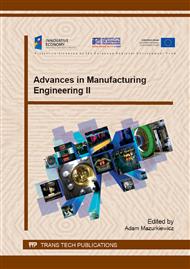[1]
K.J. Marsh, R.A. Smith, R.O. Ritchie, Fatigue crack measurement: technique and applications, Engineering Materials Advisory Services Ltd., (1991).
Google Scholar
[2]
J. Szala, D. Boroński, Ocena stanu zmęczenia materiału w diagnostyce maszyn i urządzeń, Instytut Technologii Eksploatacji - Państwowy Instytut Badawczy, Radom, 2008 (in Polish).
DOI: 10.18668/ng.2023.06.02
Google Scholar
[3]
H. Cho, Optomechatronic: Fusion of Optical and Mechatronic Engineering, CRC Press Taylor&Francis Group, (2006).
Google Scholar
[4]
V. Elango, L. Karunamoorthy, Effect of lighting conditions in the study of surface roughness by machine vision - an experimental design approach, The International Journal of Advanced Manufacturing Technology Vol. 37, No 1-2, (2008) 92-103.
DOI: 10.1007/s00170-007-0942-y
Google Scholar
[5]
S. K. Kopparapu, Lighting design for machine vision application, Image and Vision Computing Vol. 24, No 7, (2006) 720-726.
DOI: 10.1016/j.imavis.2005.12.016
Google Scholar
[6]
T. Giesko, D. Boroński, Automated machine vision systems for fatigue studies, Problemy Eksploatacji/Problems of Maintenance 50(2003) 177-188 (in Polish).
Google Scholar
[7]
M. Skorupa, T. Machniewicz, A. Skorupa, A. Korbel, The rivet flexibility measurements in a lap joint, Przegląd Mechaniczny 3 (2011) 36-41 (in Polish).
DOI: 10.2478/v10180-010-0012-0
Google Scholar
[8]
T. Giesko, D. Boroński, A. Zbrowski, P., Detection and measurement of fatigue cracks in solid rocket propellants, Problemy Eksploatacji/Problems of Maintenance 74(2009) 75-84.
Google Scholar
[9]
GOM mbH, http: /www. gom. com/metrology-systems/system-overview/aramis. html, (2014).
Google Scholar
[10]
Trilion Quality Systems, http: /www. trilion. com, (2014).
Google Scholar
[11]
J. Yan, M. Sutton, X. Deng, Z. Wei, Mixed-mode crack growth in ductile thin-sheet materials under combined in-plane and out-of-plane loading, International Journal of Fracture Vol. 14, No 4 (2009) 297-321.
DOI: 10.1007/s10704-009-9420-x
Google Scholar
[12]
A. Karpour, K. Zarrabi, A Stereo Machine Vision System for measuring three-dimensional crack-tip displacements when it is subjected to elastic-plastic deformation, http: /www. g-casa. com/E-Leader-Singapore_Program. htm, (2010).
Google Scholar
[13]
Z. Tang, J. Liang, Z. Xiao, C. Guo, H. Hu, Three-dimensional digital image correlation system for deformation measurement in experimental mechanics, Optical Engineering Vol. 49, No 10, (2010) 103601–9.
DOI: 10.1117/1.3491204
Google Scholar
[14]
T. Giesko, Dual-camera vision system for fatigue monitoring, Materials Science Forum Vol. 726, (2012) 226-232.
DOI: 10.4028/www.scientific.net/msf.726.226
Google Scholar
[15]
T. Marciniak, Z. Lutowski, S. Bujnowski, D. Boroński, T. Giesko, Application of Digital Image Correlation in Fatigue Crack Analysis, Materials Science Forum Vol. 726, (2012) 218-221.
DOI: 10.4028/www.scientific.net/msf.726.218
Google Scholar
[16]
D. Boroński, R. Sołtysiak, T. Giesko, T. Marciniak, Z. Lutowski, S. Bujnowski: The Investigations of Fatigue Cracking of Laser Welded Joint With The Use of FatigueVIEW, System, Key Engineering Materials Vol. 598 (2014) 26-31.
DOI: 10.4028/www.scientific.net/kem.598.26
Google Scholar


